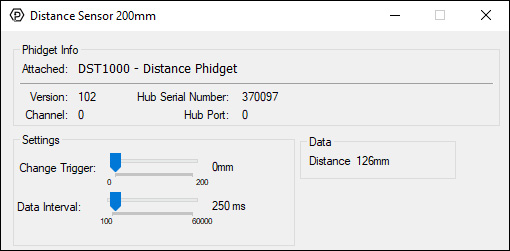DST1000 User Guide
Getting Started
Welcome to the DST1000 user guide! In order to get started, make sure you have the following hardware on hand:
- DST1000 - Distance Phidget
- VINT Hub
- Phidget cable
- USB cable and computer
Next, you will need to connect the pieces:

- Connect the DST1000 to the VINT Hub using the Phidget cable.
- Connect the VINT Hub to your computer with a USB cable.
Now that you have everything together, let's start using the DST1000!
Using the DST1200
Phidget Control Panel
In order to demonstrate the functionality of the DST1000, the Phidget Control Panel running on a Windows machine will be used.
The Phidget Control Panel is available for use on both macOS and Windows machines.
Windows
To open the Phidget Control Panel on Windows, find the ![]() icon in the taskbar. If it is not there, open up the start menu and search for Phidget Control Panel
icon in the taskbar. If it is not there, open up the start menu and search for Phidget Control Panel
macOS
To open the Phidget Control Panel on macOS, open Finder and navigate to the Phidget Control Panel in the Applications list. Double click on the ![]() icon to bring up the Phidget Control Panel.
icon to bring up the Phidget Control Panel.
For more information, take a look at the getting started guide for your operating system:
Linux users can follow the getting started with Linux guide and continue reading here for more information about the DST1000.
First Look
After plugging the DST1000 into your computer and opening the Phidget Control Panel, you will see something like this:

The Phidget Control Panel will list all connected Phidgets and associated objects, as well as the following information:
- Serial number: allows you to differentiate between similar Phidgets.
- Channel: allows you to differentiate between similar objects on a Phidget.
- Version number: corresponds to the firmware version your Phidget is running. If your Phidget is listed in red, your firmware is out of date. Update the firmware by double-clicking the entry.
The Phidget Control Panel can also be used to test your device. Double-clicking on an object will open an example.
Distance Sensor
Double-click on the Distance Sensor {{{2}}} object in order to run the example:

General information about the selected object will be displayed at the top of the window. You can also experiment with the following functionality:
- Read the distance in millimetres on the right
- Move the change trigger slider to select the minimum change required to register a new distance
- Move the data interval slider to change how fast data events come in
Technical Details
Saturation
The DST1000 will fire saturation error events when the reflected IR light doesn't reach the sensor, meaning the object is out of range. Objects that do not reflect light well might be harder to detect at greater distances.
What to do Next
- Programming Languages - Find your preferred programming language here and learn how to write your own code with Phidgets!
- Phidget Programming Basics - Once you have set up Phidgets to work with your programming environment, we recommend you read our page on to learn the fundamentals of programming with Phidgets.
